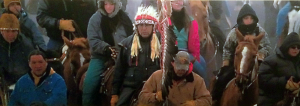
The exhibit is rather text-heavy and fails to portray the battle in an interesting manner. The controversies between the inhabitants and the American Indian people are described in great detail, but do not provide the most entertaining experience.
The National Museum of the American Indian’s newest feature is a travelling exhibit called “Commemorating Controversy: The Dakota-U.S. War of 1862.” The exhibition, created by students at Gustavus Adolphus College, provides an insight to this largely ignored part of American history.
The exhibition opened last week (Jan. 14) and will run through Dec. 29. At the end of the year it will travel to a new venue, as it has done for the past two years.
While the subject matter is very interesting, the exhibit itself is rather bland because it is simply a dozen descriptive panels of this particular war. It does not feature any unique artwork or artifacts.
Instead, the exhibit is more so a history lesson that many Americans would do well to look over, since the brutality towards American Indians is largely ignored.
The first two panels give a brief overview that introduces the topic and admits the descriptions may not sympathize with all sides of the story — as it clearly goes on to display the Dakotas as victims of brutality. The second panel is a chronological timeline of the war and its causes.
The third, entitled “Dakota Way of Being,” is the most interesting part of the exhibition. It displays a verse that provides insight into Dakota values, which include promoting their connection to the earth, animals on which they rely and the concept of a circle of life. The next nine panels explain the story of the Dakota-U.S. War of 1862.
The Dakotas were a tribe that historically lived in Minnesota. Their first white contacts were fur traders, who established peaceful trade relations with them.
However, in the mid-19th century about 160,000 white settlers came to Minnesota and conflict soon arose. Indians signed several treaties with the U.S. government that sold their land in return for payments of money and food. However, the government payments were usually late, if they even came at all, and the food was usually rotten.
Once the Dakota tribe moved from their original land, whites imposed their own values upon the Indians — dictating assimilation into their culture and urging them to convert to Christianity. One picture shows Dakota people awkwardly wearing white farmers’ outfits. When this assimilation failed, the Dakotas declared war in 1862 and most of the settlers fled.
The Dakotas ultimately lost the war to a more technologically advanced U.S. army, even though this force was largely distracted by the Civil War. Of 393 akicita (authorities), 323 were convicted of crimes and typically sentenced to death. The tribe then fled Minnesota once and for all, relocating to reservations around the Western U.S. and, according to the exhibit, the conflict still affects them to this day. The U.S. government paid the remaining money they owed the Dakotas from the treaties to aid white victims of the war instead of the tribe.
One reason the conflict has received little attention historically is because it occurred during the Civil War, which distracted President Abraham Lincoln and most of the American public. However, another explanation is probably an American sense of guilt for the unfair treatment of the Dakota tribe, which the exhibit seeks to convey.
In the late 20th century, the Indians in conjunction with local Minnesotans constructed a few monuments to the Dakotas, thus finally recognizing them. Nevertheless, the issue weakened the tribe and led them to live on non-native reservations, which has supposedly held back their communities ever since.
The controversy of the Dakota-U.S. war is undoubtedly a topic that should get more attention and an interesting feature of the National Museum of the American Indian. Yet while the content is important, the presentation lacks much appeal.
“Commemorating Controversy” is simply a collection of unoriginal panels with mostly writing. Although it was carefully organized by students, the facts presented can probably all be found using the extensive resources of Lauinger Library, which does not even begin to touch upon the wealth of information about this issue available on the Internet.
While the exhibit serves as an important reminder of this war and its place in American history, there is nothing unique about the exhibit to warrant a trip to the National Museum of the American Indian. Getting off campus and taking advantage of what Washington D.C. has to offer, such as the Smithsonian collections, is important. However, Georgetown students are also constantly busy, so this particular exhibit probably is not worth the trip down to the National Mall.


















